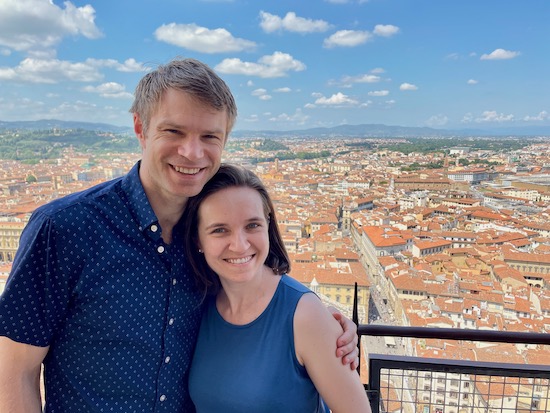
c/o Lindsay Dolan & Kolby Hanson
Did you know professors can fall in love too? This year, The Argus talked to professors at the University who are together to hear their stories of academia, romance, and everything in between.
Lindsay R. Dolan and Kolby Hanson are assistant professors of government.
The Argus: In what ways does the research you do inform each other’s work?
Kolby Hanson: We’ve joked that in graduate school, we weren’t very similar. But in a smaller, more diverse department, we’re now weirdly the closest in research areas. So we end up talking a lot about research. We know each other’s areas better than just about anyone, and share a lot of instincts for how to do research.
Lindsay Dolan: I also think there are substantive overlaps in our research. We both focus on the human resources side of the organizations we study. I study bureaucrats in intergovernmental organizations, and he studies the human resources of armed groups. We both examine how organizations are managed, who works for them, and why.
A: How did you meet?
LD: We met in grad school while doing our PhDs at Columbia [University]. I was a year ahead of Kolby, and we started dating shortly after he arrived. On our first date, we learned that we had actually debated each other in high school. I traveled a lot for debate and once attended a tournament in California, where Kolby grew up. I also kept extensive records of every single round I debated. After learning he did speech and debate, I looked up my records and it turns out that I had debated Bellarmine KH. We both have vague recollections of the round, but I found the ballot and gave it to him as a first Valentine’s Day gift.
KH: It wasn’t that sweet of a gift. The ballot was quite favorable to her and quite poor for me.
A: How do you feel about being in the same department? The same school?
KH: We didn’t start working together here until 2023. After graduate school, she commuted to Princeton [University], I to Dartmouth [College], and then taught at the [US] Naval War College. Since we started in the same department, we have a good system for separating work and life. It’s also nice to have a sanity check—going home and saying, “That was weird, right?” Being in the same department helps with that.
LD: But we also worked really hard to create boundaries, and developed those skills when we were at Columbia [University] together of not talking about work after dinner, and trying to keep parts of your life that are separate from work.
A: What’s the nerdiest or most academia-y thing that you’ve done as a couple?
LD: When planning our wedding, we ran a simulation to estimate our headcount. For each invited guest, we assigned a probability of attendance and ran 10,000 simulations to determine our expected number.
KH: The real question was how much variation to expect in the headcount. What’s the max and min if everyone decides based on probability? We overestimated our popularity, setting high attendance probabilities, so the final number was lower than expected. But it showed how our wedding size could vary just by chance.
A: How often or do students ever realize that you’re married?
KH: I don’t think we are shy about it. Sometimes we teach each other’s papers in our classes, and I don’t hide it. The main way people find out is through our dog, Bingley, who comes to campus. Since we both have Bingley, it’s pretty obvious we’re together. We also hold joint office hours, which I think is the main reason people know.
A: What’s something you admire about each other in your professional field?
LD: Kolby has real clarity for identifying the crux of a theoretical argument. He can quickly zoom in on a key assumption or dynamic that makes sense of the whole issue. I’ve always been struck by how fast he identifies that fulcrum.
KH: I’m most impressed by the thoroughness [in Lindsay’s work]. This goes beyond academic work. Social science covers many angles of a problem but also requires principledness. It sits at a weird intersection, using the scientific method, but with fuzziness in crafting arguments that aren’t strictly scientific, creating tension. I really admire Lindsay for handling this principle well—acknowledging what the evidence does and doesn’t say, and where the theory aligns or doesn’t align with the evidence. That’s pretty unusual in our field. There’s often more fudging of the scientific method than I’d like to see.
This interview has been edited for length and clarity.
Arya Dansinghani can be reached at adansinghani@wesleyan.edu.
Nancy Li can be reached at nli02@wesleyan.edu.
Thomas Lyons can be reached at tlyons@wesleyan.edu.
Lyah Muktavaram can be reached at lmuktavaram@wesleyan.edu.
Janhavi Munde can be reached at jmunde@wesleyan.edu.